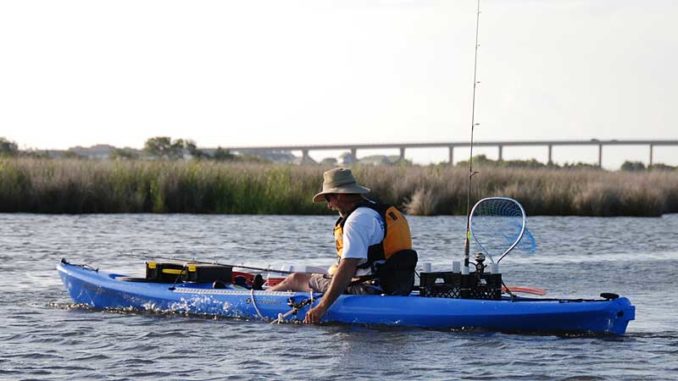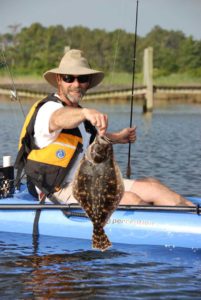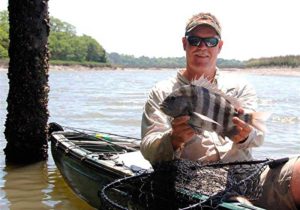
Change your schedule, lower your expectations and have a blast.
Imagine the Intercoastal Waterway along any populated stretch on the Carolina coast during July. The weather is hot. Streams of pleasure boaters are running to and fro. Throw in an equal amount of jet skis, stand-up paddlers and touring paddlers.
It’s a constant parade of vacation water traffic that makes the average kayak angler wonder if there’s even a fish to be found anywhere in sight.
Rather than fight the crowds, it’s better to adjust your fishing schedule to early and late in the day. Put your time in before the pleasure crowd hits the water or after it’s gone. You should plan on rising early, fishing until mid-morning, then returning in the late afternoon and fishing until dark.
Don’t expect to see schools of redfish nosing around in high-traffic areas. But it may be more common than you think to cash in on bottom species such as whiting, croaker, small sharks or flounder. They don’t mind it so much when things are getting stirred up. And don’t overlook predator species like bluefish, redfish or even trout to take advantage of baitfish that are moving in.
Look for obvious fish-holding areas
The most obvious cover to fish in and around the ICW and its associated cuts, canals, and sounds is man-made structure. Look for boat docks, bridges, pilings or ditches that have been dredged to allow boat traffic to pass. All of these have good fish-holding potential.

It’s hard to beat live or fresh dead baits when fishing in high-traffic, high-pressure areas. Live baits — mud minnows, shrimp and small crabs — along with cut fish, offer the appeal of both sight, smell and taste over artificial lures that may be harder to see in busy, murky water.
Stake-out poles and anchoring systems are a must for your kayak. Especially if current runs through the area. Likewise, gear to contain and keep live bait alive is a necessity if you’re using bait.
You may not have the luxury of “playing” a fish if you are around barnacle-encrusted structure. The same goes for fishing in a high-traffic area where other boats aren’t going to cut you any slack. At least medium-action, 20-pound tackle with 20- to 30-pound braided line is a good idea. If using a leader beyond the braid, a section of 40- to 50-pound mono or fluorocarbon will help get fish past the obstacles and to the side of your vessel.
Paddle up a few summer sheepshead
Targeting sheepshead from a plastic boat can be an advantage when hitting busy creeks and waterways. Sheepshead don’t seem to be as spooky as other species. That’s especially true during the summer, maybe because they’re used to hiding under boat docks. Paddlers often report sight-fishing right under the kayak on an incoming tide bringing clearer water. They look and pick sheepshead off the rocks or dock poles as they slowly paddle along.

Two approaches work for catching sheepshead from a kayak. The first is to lower a jig or rig around vertical structure like dock pilings or posts. The second is to lower the rig to the bottom. Then anglers allow the weight to sit while the bait waves in the current.
To distinguish a bite, feel for a chewing sensation that can be duplicated by rolling the leader between your fingers on a tight line. A “thump” on the line is indicative of a fish snatching the bait off the hook. This rarely results in a hookup.
Vertical presentations are best
While working your way through docks, the best method to insure a steady presentation is to hold onto the structure with one hand so you can fish vertically with the other. If a congregation of fish is under one dock or in a specific area, use a brush hook or clamp instead of anchoring or staking out. Anything that disturbs the bottom has a tendency to spook fish.
An old timer’s trick for getting sheepshead to bite is chumming. Store clams or oysters in a burlap sack and crush them into smaller pieces with a hammer. When arriving at a spot, reach in, grab a handful of crushed shell and goo and toss it in the water.
Another old school method is to pack a garden shovel or rake in the kayak. If an area that should produce doesn’t, or has been producing and stops, the paddler can reach over with the rake or shovel and scrape barnacles and shell into the water to get the party started.
Best Bets
NORTH CAROLINA
WHAT — Whiting, flounder, redfish, bluefish
WHERE — Manteo
HOW — Most kayak anglers vacationing on the Outer Banks don’t care what type of fish they catch so long as they catch something. The best “something” rig on the market is the two- hook, bottom-bouncing rig baited with mud minnows or live shrimp. Fish this on the bottom in deep water cuts, channels or around man-made structure.
LAUNCH — A popular public boat ramp is across from Pirate’s Cove Marina, on the western side of the Washington Baum (US 64) Bridge. Parking is available for up to 50 vehicles, and several pedestrian walkways offer easy, boat-free fishing. A public boat ramp in Mann’s Harbor, across the Croatan Sound from Manteo on the mainland, allows easy access to the sound.
INSIDER TIP — The Old US 64 bridge at Mann’s Harbor is a favorite kayak-fishing destination. The hundreds of pilings will hold fish from top to bottom.
SOUTH CAROLINA
WHAT — Sheepshead
WHERE — Folly Beach
HOW — Use a light-action spinning rod with a sensitive tip. Work a Carolina rig with a ½-ounce weight and a No. 2 Aberdeen bronze hook baited with a live fiddler crab around any of the old pilings.
LAUNCH — A public boat ramp on Center Street in Folly Beach will provide kayakers with access to the backside of Folly Beach and a lot of man-made structure to fish. The Sol Legare Boat Landing, off of Folly Road provides access to the Stono River and possibly less boating congestion for that immediate area.
INSIDER TIP — Make sure you are fishing in at least 4 feet of water, the deeper the better.
Click here to read about the world record spearfishing sheepshead speared out of Nags Head.

